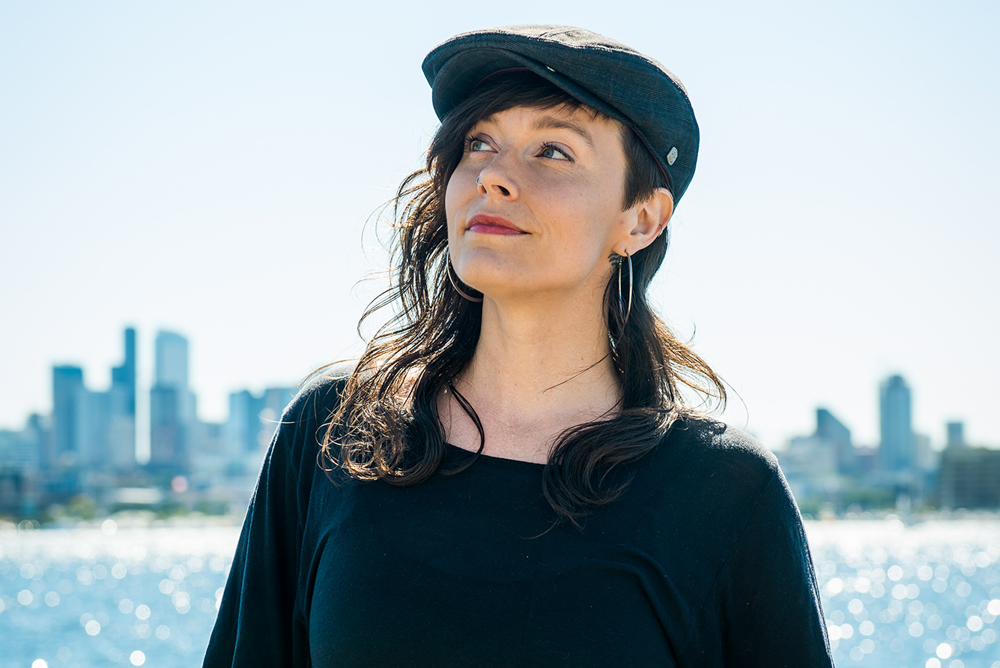When Amy O’Neal came to Seattle to study dance at Cornish in the ’90s, she arrived with a polyglot movement education, a disdainful attitude toward ballet, and an interest in the social dances she’d seen in clubs and on television. After two decades of performing and choreographing, that experience is broader. Hip-hop and breakdancing are now part of her repertoire.
O’Neal may have begun her education in a fairly conventional way, but after Cornish she pursued dance outside the traditional studio-and-company model. Between stints dancing for Pat Graney and Mary Sheldon Scott and making some of her own early choreography, she began incorporating breakdancing into her practice. Today, she says, it’s become the core of her personal aesthetic.
As a white woman working in a style first developed by black men, O’Neal found herself challenged from multiple sides. Was she authentic? Was she respectful? Was she working sincerely or just another white artist appropriating African-American culture? Disturbed by the controversy, she turned to Rennie Harris—a nationally known artist based in Philadelphia and one of the first breakdancers to create work for concert venues (he’s performed here at On the Boards)—whom she considers a mentor. His advice was to “know her history” cold—to be able to demonstrate where her influences came from and explain how she learned them.
From there, she tells me, her apprenticeship became even more intense. “I would stalk dancers at The War Room” and other clubs, she says, absorbing as much of the vocabulary and the style as she could. Alongside this detective work, she started deconstructing music videos to find the actual kinetic throughline behind the edited versions of the movement we see on the screen.
Experienced choreographer and breakdancer Amy O’Neal. Photo by Nate Waters
A good part of this research showed up in The Most Innovative, Daring, and Original Piece of Dance/Performance You Will See This Decade—a 2012 work that was as packed with references as its title was long. As a theatrical experience, it was almost too much to take in on a single viewing. Between the video and scrolling text projected on multiple screens, the spoken narration, the props (from a stripper pole to Lucite platform heels), and the audience participation section (not to mention the actual dancing), the work left audiences vibrating, but wishing they’d had a set list for all the components.
In retrospect, it felt more like a massive thesis project—a survey of everything O’Neal had learned—or a feverish night in a bar with an old friend, catching up on their life and their passions.
Since then, O’Neal seems to have been honing the movement, going deeper into the kinetic life of breaking. During last season’s Northwest New Works Festival, her solo piece Something Light for the Sake of the Dark took the physical control that is at the heart of much breakdancing and used it to focus our attention on detailed isolations and frozen, exquisite moments. It was a tour de force for her as a performer and choreographer, bringing the full toolkit of postmodern construction to bear on the task.
Her newest project, debuting at On the Boards next month, is another challenge in that direction. O’Neal won’t be dancing Opposing Forces; instead she’s enlisted some of those dancers she shadowed in the past, creating a talented cast of five. Fever One, Alfredo “Free” Vergara Jr., Brysen “JustBe” Angeles, Mozeslateef, and Michael O’Neal Jr. are award-winning performers, but they’re hardly ever seen in concert dance settings. (They represent crews including Massive Monkees and Circle of Fire and studios like The Beacon and Fever One.) During a recent rehearsal, all mentioned how unusual this project was for them, and that it was their respect for O’Neal that brought them to the project.
And it’s a tricky task she’s set for both dancers and choreographer. The difficult part is finding a balance between using breakdancing like so much material (cut and stitched into a theatrical dance) and simply replicating traditional club and competition settings. Opposing Forces aims for a middle way, to respect the integrity of form while showing it as both art and competition.
O’Neal is at a high point in her career right now: traveling to teach and stage works around the country, then squeezing in rehearsal time with her dancers, who all have busy schedules, too. More to the point, her professional life is now a fusion between dance forms that, in the past, were thought to be separate and not very equal. And in an environment where we still sometimes put our feet in just the wrong place, here’s a chance to see collaboration done right. On the Boards 100 W. Roy St., 217-9888, ontheboards.org. $23–$28. 8 p.m. Thurs., Oct. 23–Sat., Oct. 25, 5 p.m. Sun., Oct. 26.
stage@seattleweekly.com
Read more features from Seattle Weekly’s 2014 Fall Arts Guide, as well as a complete calendar of this season’s events, here.








